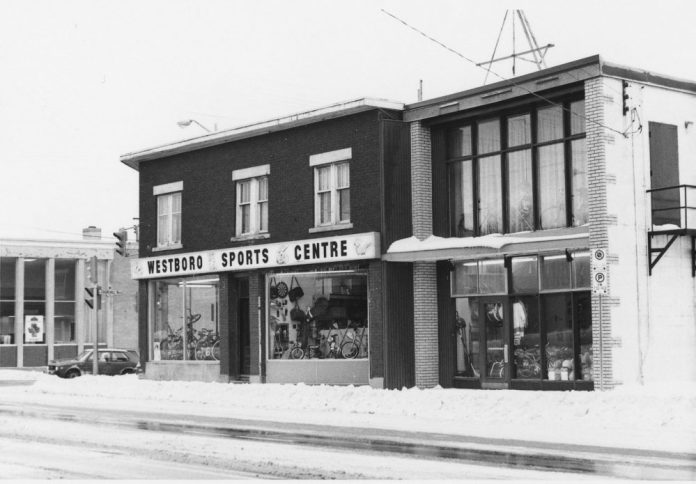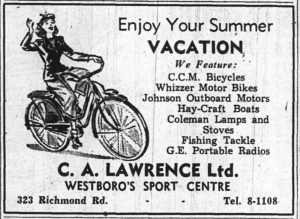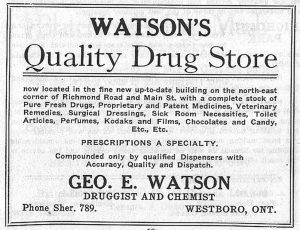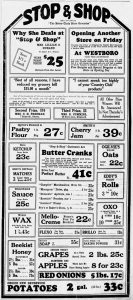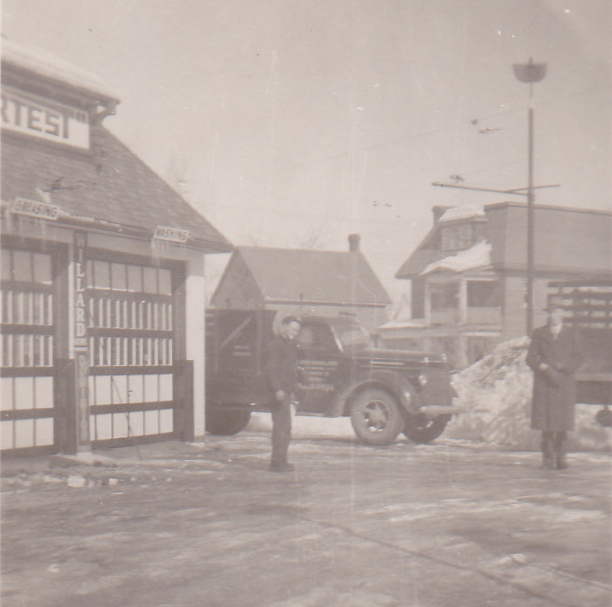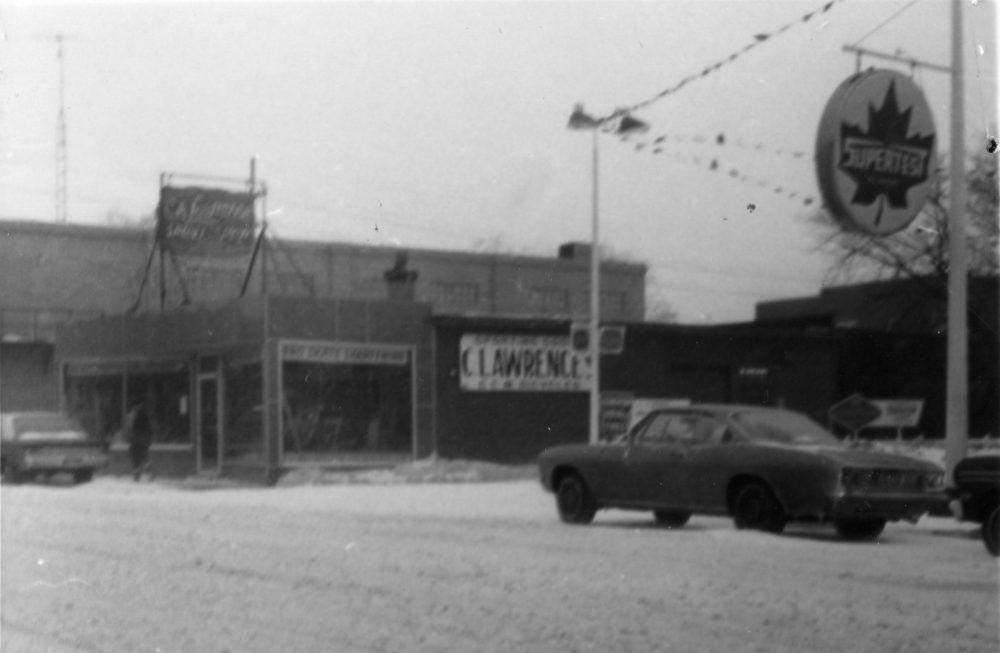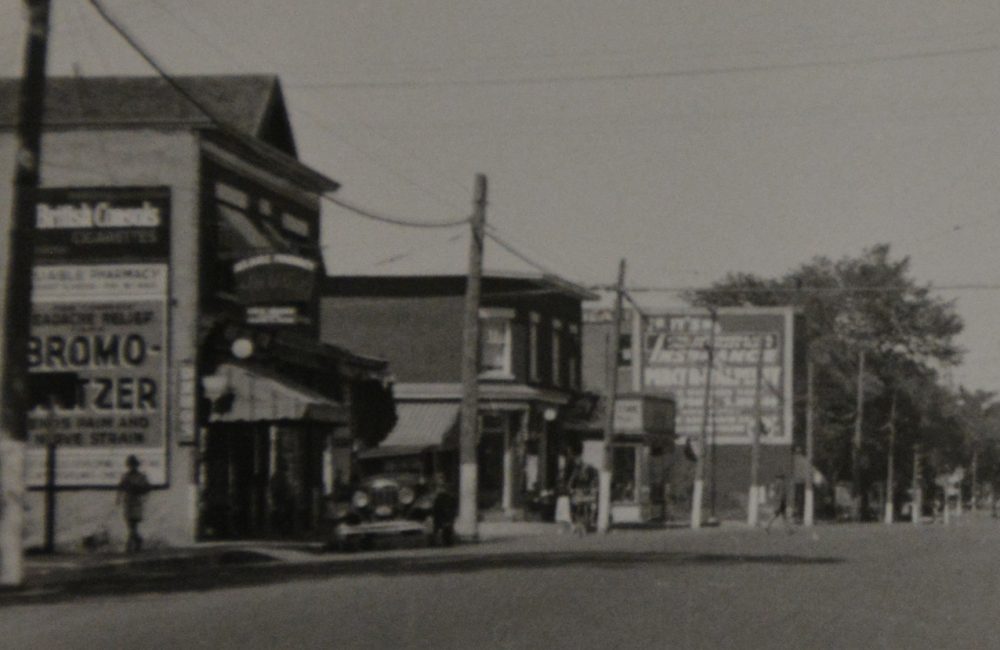By Dave Allston
One of Westboro’s most recognizable buildings, situated at the neighbourhood’s busiest intersection, will soon fall prey to a condo development. After years of sitting vacant, the former Westboro Sports Centre building, at the northeast corner of Richmond Road and Churchill Avenue, will be removed and replaced by a new nine-storey, mixed-use building, with ground floor commercial and 184 residential units. This development will take over the entire block fronting Richmond Road, another major change to a streetscape that has lost much of its original character in recent years.
This unique corner brick building has architectural features reminiscent of a small town main street shop. Indeed, when the building was first constructed, Westboro was still very much its own village and the intersection of Main and Richmond was at its heart. The little diagonal front entranceway has been passed through a million times or more over the last century, its visitors encompassing about five generations of Westboro residents.
The new condo will be the fourth different structure to stand on this exact spot. To tell the full story of the property, it would require going all the way back to 1873. The Birch family owned most of the land in the east half of the future Westboro. The part east of Churchill was actually known as “Birchton’’ long before “Westboro’’ was voted on by a handful of residents at a community meeting. 35-year-old Joseph Birch constructed a sizeable brick hotel and tavern on the corner to serve the mill workers of Skead’s Mills and the travellers along Richmond Road.
Sadly for Birch, a 2 a.m. fire in October of 1875 destroyed the barely two-year-old building, which Birch had invested $5,000 in, an enormous sum for the era. The alcohol in the bar-room literally added fuel to the fire — the entire building burned to the ground in 45 minutes. Senseless arson was believed to be the cause, as a fire had also burned down a large barn on Capt. Cowley’s property that same night (a little further to the east on Richmond Road).
Using more capital and some insurance money, Birch immediately rebuilt the hotel, a large two-and-a-half storey brick structure. But he was never able to recover financially, and lost the building to foreclosure on Christmas Eve of 1878.
Stephen and Fanny Switzer would later operate the hotel (1881-1902), before William G. and Catherine Graham acquired it in 1903 and converted it to a bakery and grocery store with a residence upstairs. The business changed hands a few times, but would largely become known as Abel Whitehorne’s Grocery store — a butcher and hardware shop from 1910-1912 and 1916-1922. Thankfully, a great photograph preserved from this era shows the old Birch Hotel/Whitehorne Grocery as it once stood (below).

Druggist George E. Watson acquired the property in February of 1927. He had opened a drug store in Hintonburg in 1897. From 1914, Watson had also been operating a drug store in Westboro in a smaller location at 376 Richmond Road (situated on what would be today’s MEC parking lot).
Watson tore down the more than 50-year-old building and constructed a fine new brick building, which was ready by the fall. He occupied the west half (331 Richmond), and rented out the east half (327 Richmond) to a new chain of grocery stores which had swept across Ottawa in 1927. “Stop & Shop” had opened their first four Ottawa stores in April and, by the fall, had at least 10, including the new Westboro location.
331 Richmond on the corner remained a drug store for the next 40 years. After Watson retired in 1940, it was operated by Gordon E. Kidd (1940-1953) and W. Hartley Hodgins (1953-1966). H&R Block was briefly a tenant (1967-1968), before it became a sports store.
Meanwhile, the Stop & Shop closed during WWII and the east portion became residential during the housing shortage during and after the war. It re-opened as a post office and stationery shop in 1946 under the operation of Harriet White. From 1924, White had been the Westboro postmistress (replacing her deceased husband who had been the postmaster for the ten years prior) at their little store on the north-west corner of Churchill. In 1946, she was forced to relocate when the post office sold that building to the Bank of Toronto (TD Bank rebuilt it in 1953, now the current home of Gezellig). The post office remained in its new location at 327 Richmond until 1951, and then the east half of the building went through a series of tenants (Nevins Stationery, Cinkants Paints, European Glass & Paint) over the next two decades.
Traditionally, there were three apartments upstairs, though for 25 years from 1933-1957, one unit was used as the dentist office of Fred Thompson and later Donald Ferguson.
Immediately adjoining the brick building, that will also be part of the demolition, is a yellow-brick building (325 Richmond) that was built in 1956 for Westhill Stationers, who remained here until 1978.
Westboro has always had a long history of sports shops (Dover’s, Clost’s, etc.) and one of the big names for many years was Charlie Lawrence. C.A. Lawrence’s Westboro Sports Centre had originally operated in a small, one-storey building adjacent to the yellow brick building (323 Richmond) beginning in 1944. That old building was demolished in 1968 to make way for an expansion of the auto garage at the corner of Winona, but it was steeped in Westboro history. Built in 1924 by Charles A. Port, the store started life as a combination of its owner’s passions: cigars (United Cigars) and flour, animal feed and poultry supplies (Westboro Feed). By 1934, it had morphed into the Westboro Bicycle & Repair Shop, operated by Robert E. Tink, who died at the young age of 40 in 1943. Charlie Lawrence took over the business, establishing the Westboro Sports Centre, a name that would live on for the next 70 years.
Charlie Lawrence sold the business to William Herbst in 1964. When the old drug store at the corner was put up for sale in 1967, Herbst bought Charles A. Port’s and moved the Westboro Sports Centre to its new location. Herbst ran the Sports Centre over both halves (327 and 331 Richmond), and even later expanded into the yellow-brick building next door in 1978 as well. His sons, Geoff and Doug, eventually took over and ran the business until it closed on July 31, 2012, just three months after Doug passed away from cancer. Other than for short-term projects, it has sat vacant ever since.
The Avenues Garage at the corner of Winona, which will also be part of the condo development, also has a long history. Though the current structure dates to just 1968, the first gas station opened on this spot in 1934. It opened as a Supertest station and remained so until the 1970s. It became Avenues Garage in 1983.
Like any street block in Westboro, summarizing 150 years of history into a thousand words is almost impossible. Every lot, every structure has a unique and interesting history that has played a role in the lives of every Westboro resident through time. Whether it was a trip to buy a first pair of skates, a bicycle, a prescription or chicken feed, these familiar buildings hold special significance to many, and that little bit of intangible history is lost when the bulldozers arrive. Though we can’t preserve every building, and nothing can stay the same forever, it is fair to mourn a little when the connecting pieces to Westboro’s past are slowly lost.
